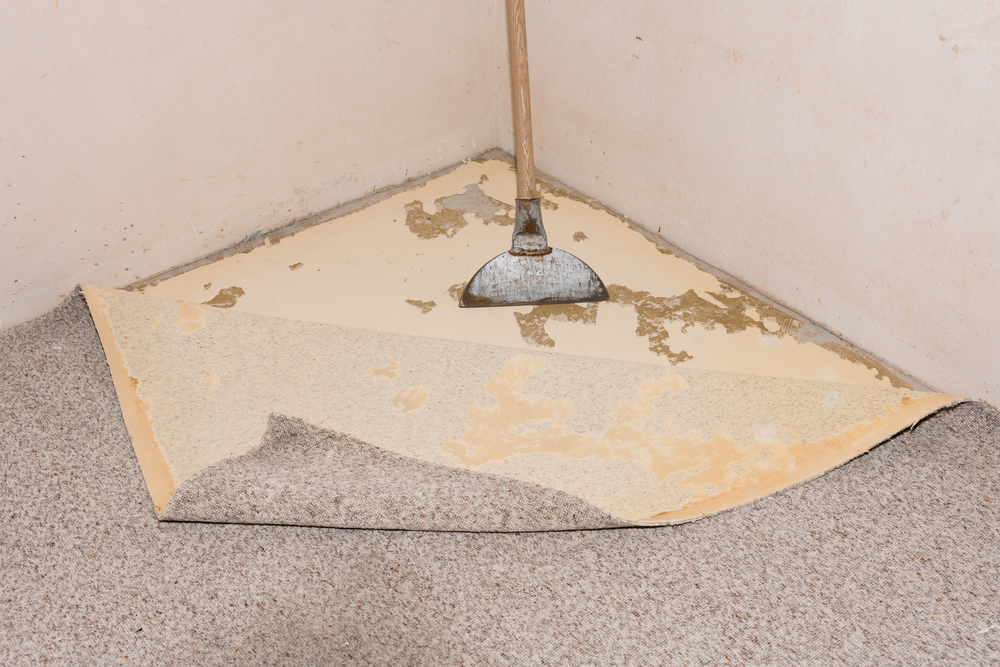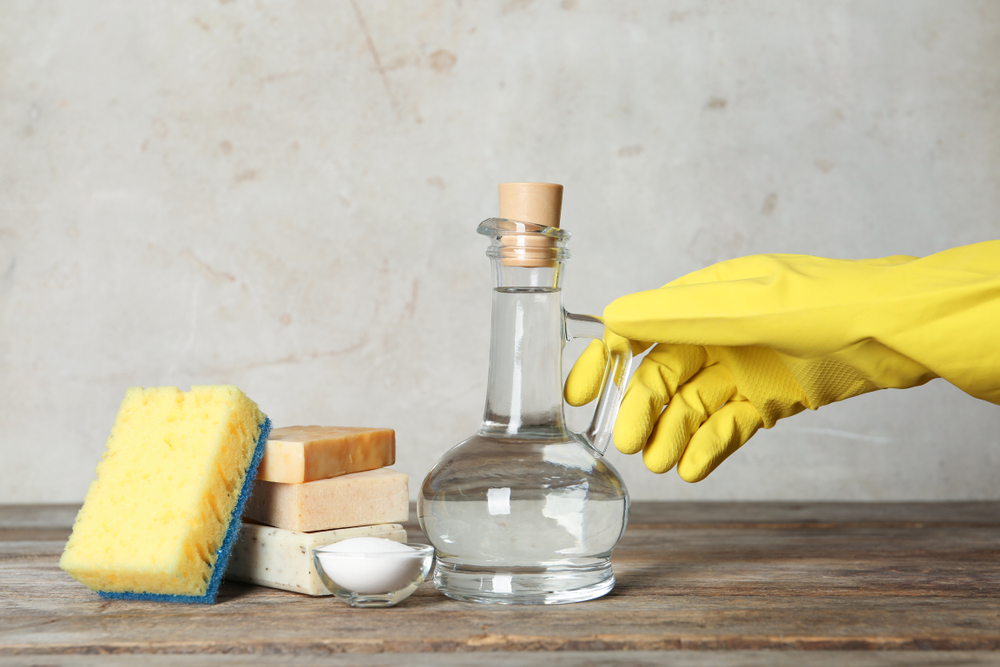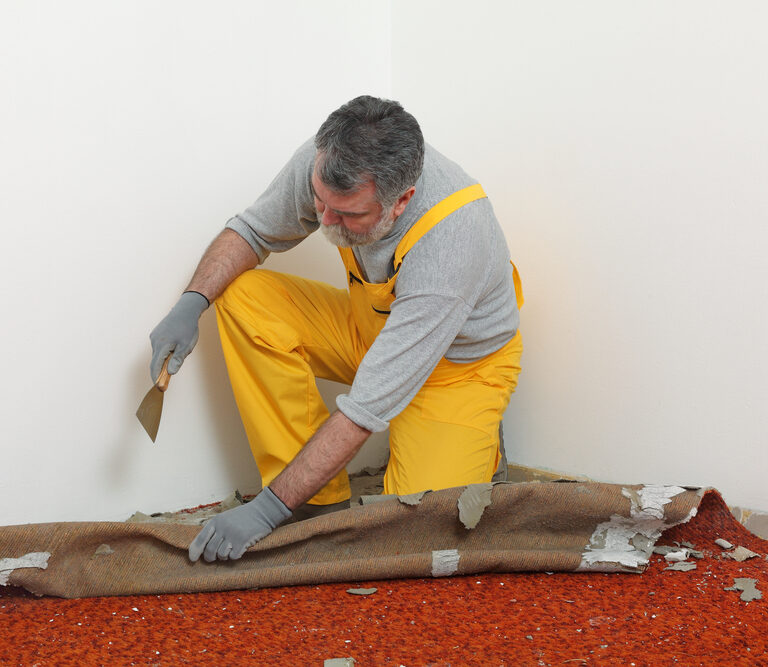It certainly isn’t easy to rip up your old carpet. However, knowing to remove carpet glue from the floor beneath it is an even bigger challenge. It’s absolutely essential to create a smooth and clean service if fresh adhesive is going to be able to create a strong bond between the subfloor and your new flooring. So, you’re going to need to find a way to get the job done as quickly and easily as possible.
There is a selection of products available to make it easier to get carpet glue off concrete. However products that are chemical strippers can emit potentially hazardous fumes while more eco-friendly options may not be as effective. With this in mind, removing the carpet glue manually could be the best option.
Here, we take a closer look at the best ways to remove carpet glue from your floor so you can fit your new flooring as painlessly as possible.
- Which Tools Do I Need to Manually Remove Carpet Glue From Concrete?
- How Do I Remove Carpet Glue From Concrete?
- How Do I Remove Carpet Glue From Wooden Surfaces?
- Are There Any Other Ways to Remove Carpet Glue?
- Is There a Simple and Effective Homemade Carpet Glue Remover?
- A Final Word About How to Remove Carpet Glue
Which Tools Do I Need to Manually Remove Carpet Glue From Concrete?

If you’re going to remove carpet glue from your floor manually, you’ll require the following equipment and tools:
- A scraping tool (a hoe or spackling tool will work well)
- Knee pads
- Work gloves
- Safety goggles or glasses
- Electric kettle full of boiling water
- Waterproof work boots
- A broom
- A towel or mop
How Do I Remove Carpet Glue From Concrete?
Many homeowners today are choosing to pull up their carpets and enjoy the stylish appeal of the concrete floor beneath. Many more just want to fit a new carpet onto the concrete for a fresh new look. Either way, removing the existing carpet glue is essential and the manual scraping method is often a popular choice.
Follow this process to get the job done as easily and speedily as possible:
- Scrape down the floor using your hoe or spackling tool. This will remove the maximum amount of residue as well as the remaining fragments of your old carpet.
- Use a broom to clean away any resulting debris.
- Put on your protective clothing (your boots, goggles, gloves, knee pads etc).
- Boil the kettle the pour boiling water onto the floor.
- Allow the water to sit for a few minutes but don’t wait so long that the water cools too much since this could result in the glue hardening again.
- With the scraping tool, work gently under the glue. Take care not to damage the surface of the concrete. If there are any spots that are especially tricky, add a little more of the boiling water to the surface to soften up the glue further.
- Once you’ve completely scraped up all the glue, use a mop or towel to clean up any remaining water on the floor and leave it to dry naturally.
- Sweep the remaining debris away so the concrete is clean once more and ready to use.
How Do I Remove Carpet Glue From Wooden Surfaces?
Wood floors are especially popular at the moment, so if you’re taking up an existing carpet to reveal the beauty of the natural wooden surface beneath you need to make sure that all of the carpet glue is removed in such a way that the flooring below isn’t damaged.
There are a number of ways in which carpet glue can be removed from wooden floors, but you’ll need to take care to avoid any unwanted scratches and scrapes on the surface.
Here are a few of the most common ways of removing carpet glue from wood:
Dry Ice
Although this is an unusual option, dry ice can remove carpet glue from your wood floor. If you choose this method, make sure you’re wearing protective gloves. You should also ensure the space has been properly ventilated. Just put the dry ice onto a cookie baking sheet then slide the tray slowly over the areas of residual glue. They will become brittle so you can chip them off safely and easily.
Using Solvents
This is a relatively easy method, however, it presents a greater risk of damaging or discoloring the wood. You will also need to wear protective clothing as well as ensuring that the room is well ventilated.
You will require different products depending on which kind of adhesive is on your floor:
- Work out which kind of adhesive has been used on your wooden floor. General adhesives for carpet have a yellow color while adhesives that are tar-based are brownish in color.
- Choose the right solvent product to suit the kind of glue. Usually, general adhesives will be best removed with a solvent with an orange oil base. If the adhesive on your flooring is tar-based though, you’ll need a mineral spirit product.
- Apply the solvent product to the floor, following all instructions carefully. Depending on the product, it may take as little as a few minutes or as long as a few hours to completely set.
- Scrape the soft glue gently away from the floor using a plastic putty knife. If you use a metal knife you could scrape the wood and cause scarring, so this should be avoided.
- Use a cloth that has been soaked in solvent to scrub any glue that remains away. In some cases, you may have to scrape resilient glue away using a metal putty knife, but if this is necessary it must be done very carefully as you could damage the wood.
- Follow the instructions on the product label to clean up the treated area or use a wet-vac to clean the floor. Gently scrub using dilute apple cider vinegar or detergent to detoxify the floor.
- Allow 24 hours for the floor to completely dry, ensuring excellent ventilation throughout before trying to furnish the space or add a flooring finish. This will prevent any moisture that remains from getting trapped inside the wood and causing issues like warping.
Unconventional Solvents
Some alternatives exist to standard commercially available solvents and these are often easier to get hold of. Unfortunately, though, they all come with a risk of discoloring or damaging the wood. They include:
- Paint remover – very effective, however it can cause damage to wood easily.
- Denatured alcohol – again, this is high risk however it can be helpful on very stubborn glue patches.
- WD-40 – this works very well if applied in small amounts on a soft cloth before being allowed to rest for 30 minutes.
- Vegetable oil – this works very well on yellow adhesive products if worked in carefully using a soft cloth however it may stain.
Are There Any Other Ways to Remove Carpet Glue?
If you’ve tried removing carpet glue from your floor and achieved poor results, there are a couple of other options you can try:
- Use a steam cleaner – a portable model is best. You can buy or rent these pieces of equipment. Just direct the steam flow a couple of inches away from the surface of the carpet glue until you it has been softened sufficiently to scrape away. Try steaming small sections and scraping each one as you go so the glue can be lifted before cooling and hardening up again.
- Use a reciprocating saw – if the carpet glue is especially stubborn or you need to remove it from a larger area, a reciprocating saw that has been fitted with a scraper attachment can be very helpful. It will significantly reduce the length of time you need to spend scraping since the blade’s vibrations will do the hard work on your behalf. Use a 2” or 4” blade and position the scraper attachment so the beveled edge points upwards. Holding the reciprocating saw at a low angle, run it at a slow speed and gradually increase the speed so the glue lifts up quickly and effortlessly.
Is There a Simple and Effective Homemade Carpet Glue Remover?

If you’re keen to use an eco-friendly and natural homemade carpet glue remover for concrete surfaces , you can simply make a solution of white vinegar and water. Since vinegar is acidic, it can dissolve sticky residue like glue.
- Add an equal amount of white vinegar and hot water to a bucket and stir to make a solution.
- Pour it onto any areas of carpet glue residue on a concrete surface.
- Allow to rest for a few minutes to allow the vinegar to dissolve the glue.
- Using a scrubbing brush, remove the remaining glue.
- Rinse the treated area using clean water.
A Final Word About How to Remove Carpet Glue
Although it may seem difficult to remove carpet glue from your underlying floor, the good news is that if you follow the steps outlined above it should be easier than you imagined.
It’s important to be aware of the potential hazard posed by asbestos though. Before the 1990s, some carpet glues were made using asbestos which is known to have severe health consequences if inhaled. If you’re removing an old carpet, you should, therefore test them before trying to chip or scrape them as this may release harmful particles into the environment. If you’re in any doubt, it’s best to hire a professional to come and remove the residual carpet glue from your floor.
